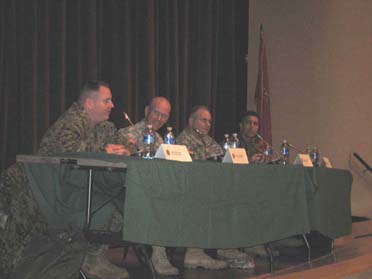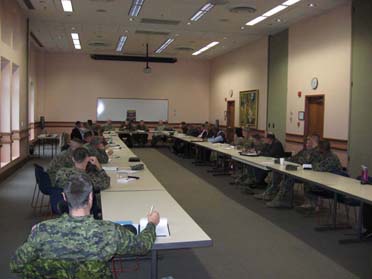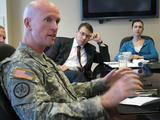Delegate Beyond Point of Comfortby Ken White
The tendency in the United State Armed Forces to micromanage is inimical to competency in combat and has adverse implications for doctrinal development. We should train to eliminate it yet instead we tacitly -- some would say overtly -- encourage it.
Colonel Daniel S. Roper, Director, USA/USMC COIN Center, 10 Dec 07 Iraq visit briefing (extract):
Delegation. OODA loop so tight, if capabilities, lethal or non-lethal, (e.g., AH, $, Intel, PSYOPs) not pushed to executor, may miss window of opportunity. Delegate beyond point of comfort. (emphasis added)
Why should such an obvious thing have to be said?
Because our egos are so large that we discard the lessons of history and sometimes even our training for our own determination of what is required and we know we cannot trust our subordinates to do it our way? Since we have been successful, obviously our way is correct...
That may be unfair and it certainly does not apply to all but it does apply to many; more importantly, we often forget it does not have to be our way to be correct and when we do remember that, we recall that our subordinates are not as capable as we'd like. Thus we eschew delegation and micromanage. We do this in the face of historical precedent in all our wars that this is practiced on entry and is discarded as dangerous as we gain experience in that war. See First Manassas or Kasserine Pass and compare those with later unit and soldier actions at Yellow Tavern and penetrating the Siegfried Line in the same wars.
I applauded when I was told that had been stated by Colonel Roper. Seemed like a long overdue observation to me. I have watched the progress of micromanagement in the Armed Forces of the United States since World War II. Watched it with considerable fear and trepidation. Even got to operate under it for many years...
While my comments apply to all four services and to the Department of Defense as an entity, I am more familiar with the US Army and will address just it in detail.
Brain McAllister Linn in his excellent book The Echo of Battle: The Army's Way of War discusses the doctrinal battles and squabbles of the US Army from its birth through last year. He well captures the current arguments between major war and Counterinsurgency warfare proponents -- and illustrates that is not at all a new argument but one with ancient roots. It's an excellent book and it has some cautionary words for today's leaders.
He suggests that Army leaders fall into three broad categories he describes as 'Guardians, Heroes and Managers.' My observation over many years is that he gets much of that right. Guardians are 'big war' proponents; Managers have obvious tendencies and the Heroes tend to elevate the Soldier above technique or equipment. Heroes also tend to be accepting of if not proponents of small wars, Guardians oppose them and Managers also tend to lean that way (they are 'inefficient'). Obviously any categorization of an institution as large as the Officer Corps of the US Army into three subsets is somewhat simplistic but it suffices in the case of that book. Those in the Armed Forces will immediately recognize their acquaintances as belonging to one group or another.
Doctor Linn does not spend much time on the topic of delegation versus micromanagement though he does address it in passing -- it is after all a matter of historical record and reality. I suggest that tension has every bit as much if not more to do with the future direction of the Army as does that between his cited categories.
Perhaps much more.
There has long been a tension between Officers and NonCommissioned Officers who prefer well disciplined soldiers who obey orders with few questions and their leader counterparts who wish to command or lead thinking soldiers, encourage questions and don't get too upset at minor indiscipline. While there is a slight tendency for the Linn Heroes to prefer the thinking soldier, the two schools of thought have proponents in all his categories. However, in the division between micromanagers and delegators, the former tend to strongly prefer unthinking obedience while the latter obviously require thinking soldiers.
Briefly consider ramifications of that thought...
There is a further complication. Branch or Combat Arm modalities and experience produce pressures that encourage micromanagement or decentralization. Artillerists require mathematical precision, can do great damage and thus do not encourage 'out of the box' thinking. Armor and Mechanized Infantry need focused efforts, good gunnery and pretty strong adherence to plans in vehicles that do not break down. Aviators have truly significant safety concerns and know that use of the checklist precludes error. All those arms have peacetime and training routines that emphasize 'metrics' -- Tankers and Bradley unit Commanders are effectively graded on their gunnery and maintenance statistics. Tactical training is considered but pales into insignificance in comparison to the tables and OR rates. Artillery and Aviation Commanders also have range and maintenance efforts that take primacy. There is no question that gunnery and maintenance are imperative -- but so also are the people who do those things and the tactical aspects. Regardless, the point is those efforts encourage a degree of micromanagement.
Consider, on the other hand the Infantry Commander. People are his primary concern as he can do nothing in his mission set without them; his range scores are not indicative of much, his maintenance requirements are slight in comparison to other arms. Thus he has some inclination to not micromanage. The Cavalryman tends for many reasons to blend armor and infantry attributes. These two tend to favor decentralization and delegation.
That said micromanagers are almost as prevalent in the Infantry and Cavalry as they are elsewhere so we are confronted with the fact that it must be at least in part, a human predilection. The thing that must be considered is just how much we reinforce that tendency. It is important to recall that the tendency has been prevalent throughout our history and that it goes by the wayside as the war progresses. It does this as experience replaces inadequate training and as the tempo of operations becomes (sometimes -- Counterinsurgency and Foreign Internal Development are usually not fast paced overall) more rapid and greater dispersion becomes necessary.
A look at that last 50 years in the Army can offer some illumination. In 1958, the Army had just completed the shift into a Pentomic organization. This, effectively, placed one Colonel and two Lieutenant Colonels in charge of a large Battalion. This was done not because the organization required the knowledge and experience of a Colonel but to justify and not lose those Colonel spaces. Regardless of why, it taught a number of Colonels and Lieutenant Colonels to worry about echelons below their skill level as those senior officers had experienced Company, Battery and Troop Commanders, many commanding their second or even third company level unit.
Then came Robert Strange McNamara with Whiz Kids, Ford Motor Company (Haven't I heard something about them lately...) management techniques, an ego bigger than Alaska and the introduction of the zero defects mentality. This was followed by our entry into Viet Nam. A system of one year individual tours to the combat zone was in effect. Due to several factors, by late 1968, there was a shortage of Captains and experienced Non-Commissioned Officers. The former problem was addressed by producing more Lieutenants, the latter by developing a NonCommissioned Officer Candidate Course that was conducted at several Posts and produced a plethora of new Sergeants.
Battalion Commanders in Viet Nam post late 1968 quickly discovered they had few Captains and Senior NonCommissioned Officers but plenty of truly dedicated young Lieutenants and Sergeants who would try to do anything you asked of them. Problem was, they were inexperienced and didn't know much -- so they had to be watched extremely closely. Thus as a result of a very senior exemplar of micromanagement, a very flawed personnel policy and inadequate training, a generation of future Generals learned to micromanage.
They also learned that Counterinsurgency was tedious, dirty, unfulfilling and to be avoided -- but that is another story.
Micromanagement has always been about. However, as a result of occurrences in the 1958-1975 time period the techniques was elevated to an art form and for the first time became firmly embedded in the US Army as the preferred way to do business. Sporadic attempts in the 1970s and 1980s by visionary senior people like Generals Edward C. Meyer and Lieutenant General Walter Ulmer to stop this insidious trend were derailed by the bureaucracy that simply waited until they were gone and reemployed its strait jacket. Compliance and mediocrity were desired.
In the past, we have had time in all our wars -- though at the cost of unnecessary casualties and losses -- to discard the peacetime tendency to micromanage. The most recent example of this phenomenon is of curse Iraq. We had 18 moths of initial lost time and many missteps; it took another 18 months to work out the kinks and only in the last 18 months have successes been achieved. A very significant question today is will that time be available in the future? Given the size of the force, can those unnecessary casualties be afforded?
We are now in a new Century. We have a fully professional Army that is hobbled in performance by an archaic training system and what is essentially a World War and draftee based personnel system that insists all persons of like grade and specialty are equal. This is obviously a patently incorrect assumption and policy. Inadequate initial entry training for both Officers and Enlisted persons -- as well as some shortfalls in professional military education -- and insistence on retaining that personnel system literally force us into micromanagement.
Congress is a big driver in personnel matters in an attempt to be fair and equitable. I applaud their intent. Unfortunately, they don't seem to understand that being fair and equitable in such a manner causes significant death and destruction to their voter's sons and daughters because combat is not fair and equitable. Surely that can be explained to them.
The Army -- all the services -- must consider the ramifications of micromanagement on force design. They also need to train people to avoid micromanaging their subordinates. More importantly, the US Army needs to acknowledge that micromanagement occurs because too many are afraid to trust their subordinates. It's really that simple.
People are micromanaged because of the perception they can't be trusted.
They, in the case of the US Army, can't be trusted because too many subordinates are inadequately trained and too many leaders are in jobs they should not have. Whatever the force structure decisions those errors need to be remedied.




